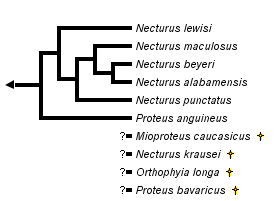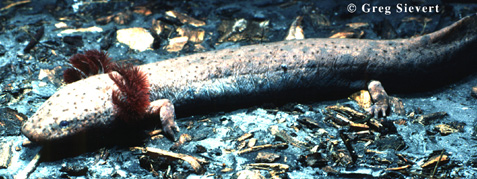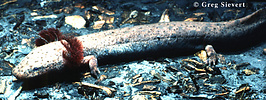Proteidae
Mudpuppies, waterdogs
Allan Larson


This tree diagram shows the relationships between several groups of organisms.
The root of the current tree connects the organisms featured in this tree to their containing group and the rest of the Tree of Life. The basal branching point in the tree represents the ancestor of the other groups in the tree. This ancestor diversified over time into several descendent subgroups, which are represented as internal nodes and terminal taxa to the right.

You can click on the root to travel down the Tree of Life all the way to the root of all Life, and you can click on the names of descendent subgroups to travel up the Tree of Life all the way to individual species.
For more information on ToL tree formatting, please see Interpreting the Tree or Classification. To learn more about phylogenetic trees, please visit our Phylogenetic Biology pages.
close boxRelationships among the six extant species of the family Proteidae based upon allozymic data (Guttman et al., 1990). Results of a cytological study (Sessions and Wiley, 1985) differ only in placing N. beyeri closer to N. maculosus than to N. alabamensis; the allozymic data suggest that these species approximate a three-way split and that their exact relationships are not definitively resolved.
For more information on fossil species, see Estes (1981).
Introduction
Salamanders of the family Proteidae are permanently aquatic, and maintain throughout life the large, filamentous gills and caudal fins characteristic of larvae. Proteus is a European, subterranean salamander, that lacks pigment and has degenerate eyes. The body is slender and has reduced numbers of toes on the forelimbs (three) and hindlimbs (two). It is moderately large, reaching an adult length of about 30 cm.
Necturus is an eastern North American genus that has normal pigmentation and eyes and 4 digits on each foot. Members of the genus Necturus are commonly called "mudpuppies" or "waterdogs." They inhabit streams, rivers and lakes, where they remain concealed under rocks and debris during the day and forage for invertebrate prey at night.
Breeding occurs in spring. Fertilization is internal. Eggs are attached to the undersides of stones and logs, and may be guarded by males or females. Larvae hatch in early summer and may require 4-6 years to reach sexual maturity.
The grouping of the genera Necturus and Proteus as the family Proteidae is controversial. This grouping has been favored by Estes (1981) and Duellman and Trueb (1986) but challenged by Hecht and Edwards (1977). The shared features that cause these genera to be grouped taxonomically are possibly a result of parallel, paedomorphic evolutionary trends and not strongly indicative of common ancestry.
The family Proteidae extends temporally at least to the Upper Paleocene in North America and to the Middle Miocene in Europe and Kazakhstan (Estes, 1981).
Characteristics
Diagnosis
All proteids are permanently aquatic larvae with elongated bodies, long filamentous gills and a caudal fin. Proteids of the European genus Proteus are cave dwellers with depigmented skin and degenerate eyes. American proteids of the genus Necturus have robust bodies that are usually dark brown, grey or black on the dorsal surface which often has a mottled appearance; four toes are present on robust forelimbs and hindlimbs.
Detailed Characteristics of the Proteidae
The morphological characters given below are the ones standardly used to diagnose the salamander family Proteidae and to assess its phylogenetic relationships to other salamanders. The individual characteristics are in most cases shared with other salamanders and should not be interpreted as synapomorphies of the Proteidae. Absence of characteristics found in other salamanders is noted where it is important for distinguishing proteids from other salamanders and/or determining their relationships to other salamanders. These characteristics were assembled from a large number of original sources by Duellman and Trueb (1986), Larson (1991) and Larson and Dimmick (1993).
Metamorphosis is absent in the Proteidae, leading to a number of paedomorphic features in adults.
Morphology of the Skull
The premaxilla consists of separated, paired bones. Bilaterally paired nasal bones each ossify from a single, laterally positioned anlage; long posterior processes of the premaxillae extend between the paired nasal bones and completely separate them. Maxillary bones are absent. Bilaterally paired septomaxillary bones are absent. Lacrimal bone is absent. Quadratojugal bone is absent. Pterygoid bones are present. An internal carotid foramen is present in the parasphenoid bone. The angular bone is fused to the mandible. Ear bones include a detached columella but no operculum. Replacement of vomerine teeth proceeds laterally in parallel to the maxillary teeth. Teeth have a distinct crown and pedicel. Origin of the levator mandibulae anterior superficialis muscle includes the exoccipital.
Inner Ear
A basilaris complex is absent from the inner ear. The recessus amphibiorum is oriented vertically in the inner ear. The otic sac is bulbar and unvascularized. The amphibian periotic canal lacks fibrous connective tissue. The periotic cistern is large and does not protrude into the fenestra.
Hyobranchial Structures
The first hypobranchial and first ceratobranchial (alternatively homologized as the first ceratobranchial and first epibranchial, respectively) exist as separate structures. The second ceratobranchial (alternatively homologized as the second epibranchial) comprises a single element. Lungs are present but the ypsiloid cartilage is absent. Two pairs of gill slits are present.
Characteristics of the Trunk and Vertebral Column
The scapula and coracoid bones of the pectoral girdle are fused to form the scapulocoracoid. Vertebral centra are amphicoelous. Ribs are bicapitate. Spinal-nerve foramina are absent from all vertebrae. Anterior glomeruli of the kidney are reduced or absent.
Reproductive Characters
Fertilization is internal. Ciliated epithelium is absent from the cloacal tube and anterior cloacal chamber of females. Epidermal lining is present in the anterior cloacal chamber of females. Evaginations are absent from the dorsolateral walls of the male cloacal tube. Anterior ventral glands are present in the cloacae of females. Spermathecae are present in the female cloacal chamber. Glands secreting into the dorsal walls of the female cloaca are absent. Anterior ventral glands are present in male cloacae. Posterior ventral glands are present in male cloacae. Kingsbury's glands are present in male cloacae. Dorsal pelvic glands are present in males. Lateral pelvic glands are present in males. Glands secreting into the male cloacal orifice are present. Parental care of eggs is by males or females.
The diploid number of chromosomes is 38 (see Morescalchi, 1975).
Classification
The family Proteidae is part of the caudate suborder Salamandroidea, which contains all of the internally-fertilizing salamanders. The grouping of the genera Necturus and Proteus into a single family has been controversial and should be considered tentative.
The single recognized species of Proteus is sometimes listed as P. anguineus and alternatively as P. anguinus.
Discussion of Phylogenetic Relationships
The Proteidae is a tentative grouping of the genera Necturus and Proteus, whose status as sister taxa is still questionable.
Analyses of allozymic data (Guttman et al., 1990) and cytological data (Sessions and Wiley, 1985) agree that Necturus lewisi is the sister taxon to the remaining species of Necturus, and that N. punctatus is the sister lineage to a group including N. alabamensis, N. beyeri and N. maculosus. The allozymic data indicate that the lineages leading to N. alabamensis, N. beyeri and N. maculosus approximate a three-way split, and slightly favor a sister grouping of N. alabamensis and N. beyeri relative to N. maculosus. The cytological study of Sessions and Wiley (1985) groups N. beyeri with N. maculosus rather than with N. alabamensis. Relationships among the latter three species are perhaps best viewed as approximating a three-way split, with the alternative hypotheses derived from the allozymic and cytological data being tentative and in need of further testing.
The immunological data of Maxson et al. (1988) were ambiguous in their resolution of the phylogenetic relationships among the species of Necturus.
References
Duellman, W. E. and L. Trueb. 1986. Biology of Amphibians. McGraw-Hill, New York.
Estes, R. 1981. Gymnophiona, Caudata. Handbuch der Paläoherpetologie 2:1-115.
Larson, A. 1991. A molecular perspective on the evolutionary relationships of the salamander families. Evolutionary Biology 25:211-277.
Larson, A. and W. W. Dimmick. 1993. Phylogenetic relationships of the salamander families: A analysis of congruence among morphological and molecular characters. Herpetological Monographs 7:77-93.
Guttman, S. I., L. A. Weight, P. A. Moler, R. E. Ashton, Jr., B. W. Mansell and J. Peavy. 1990. An electrophoretic analysis of Necturus from the southeastern United States. Journal of Herpetology 24:163-175.
Maxson, L. R., P. E. Moler ad B. W. Mansell. 1988. Albumin evolution in salamanders of the genus Necturus. Journal of Herpetology 22:231-235.
Morescalchi, A. 1975. Chromosome evolution in the caudate Amphibia. Evolutionary Biology 8:339-387.
Sessions, S. K. and J. E. Wiley. 1985. Chromosome evolution in the genus Necturus. Brimleyana 10:37-52.
Title Illustrations

| Scientific Name | Necturus alabamensis |
|---|---|
| Comments | The Alabama waterdog |
| Copyright | © 1996 Greg Sievert |
About This Page
David Heyse, Todd Jackman, Paul Moler, Stanley Sessions and Greg Sievert contributed to the preparation of this Tree of Life page.
Allan Larson

Washington University, St. Louis, Missouri, USA
Page copyright © 1996 Allan Larson
All Rights Reserved.
- First online 23 August 2006
Citing this page:
Larson, Allan. 2006. Proteidae. Mudpuppies, waterdogs. Version 23 August 2006 (under construction). http://tolweb.org/Proteidae/15449/2006.08.23 in The Tree of Life Web Project, http://tolweb.org/







 Go to quick links
Go to quick search
Go to navigation for this section of the ToL site
Go to detailed links for the ToL site
Go to quick links
Go to quick search
Go to navigation for this section of the ToL site
Go to detailed links for the ToL site